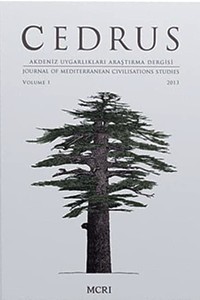Aleksandreia Troas’tan Quintus Burricius Follius Classicus Onuruna Yeni Bir Yazıt
Aleksandreia Troas, Quintus Burricius Follius Classicus, Ornamenta, Decurionalia, Duoviralia, Sacerdotalia
A New Inscription from Alexandreia Troas, Honouring Quintus Burricius Follius Classicus
Alexandreia Troas, Quintus Burricius Follius Classicus, Ornamenta, Decurionalia, Duoviralia, Sacerdotalia,
___
- Bailie J. K. 1846, Fasciculus inscriptionum, graecarum potissimum, quas apud sedes celeberrimas Asianas chartis mandata, et nunc denuo instauratas, notisque tum criticis tum exegeticis instructas. Dublin - London. Borzsák S. 1939, “Ornamenta”. RE XVIII/1, col. 1110-1122.
- Brelaz C. & Rizakis A. 2003, “Le fonctionnement des institutions et le déroulement des carrières dans la colonie de Philippes”. Cahiers du Centre Gustave Glotz 14, 155-165.
- Chase G. D. 1897, “The Origin of Roman Praenomina”. Harvard Studies in Classical Philology 8, 103-184.
- Eck W. 2007, “Ornamenta”. Brill’s New Pauly, Antiquity X, col. 221-222.
- Esch T. 2018, “Die Quintilii aus Alexandria Troas: Aufstieg und fall einer familie”. Ed. E. Schwertheim, Neue Forschungen in Alexandria Troas (AMS 88). Bonn, 1-60.
- Gasperini L. 1971, “Il municipio tarentino. Ricerche epigrafiche”. Miscellanea Greca e Romana 3, 143-209.
- Gil E. M. & Neila J. F. R. 2012, “La integración real o ficticia en los ordines decurionum: Lecti, cooptati, adlecti y ornamentarii”. Epigraphica 74, 109-171.
- Gizewski C. 2004, “Decurio, decuriones”. Brill’s New Pauly, Antiquity IV, col. 164-166.
- Gregori J. L. 2008, “Huic ordo decurionum ornamenta … decrevit. Forme pubbliche di riconoscimento del successo personale nell’Italia Romana”. Eds. C. Berrendonner et al., Le quotidien municipal dans l’occident romain. Clermont —Ferrand, 661-685.
- Kajanto I. 1982, The Latin Cognomina. Rome.
- Kleijwegt M. 1992, “The value of empty honours”. Epigraphica 54, 131-142.
- Kuhn A. B. 2012, “Herodes Atticus and the Quintilii of Alexandria Troas: Elite Competition and Status Relations in the Graeco-Roman East”. Chiron 42, 421-458.
- Lécrivain C. 1918, “Ornamenta”. Eds. C. Daremberg & E. Saglio, Dictionnaire des antiquités grecques et romaines d’après les textes et les monuments IV/1. Paris, 238-239.
- Özhan T. & Yaman H. 2019, “A New Inscribed Assos Sarcophagus from Alexandreia Troas and The Collegium of Shipwrights”. Gephyra 18, 77-95.
- Özhan T. 2015, “New Inscriptions from Smintheion: Dedications, Epitaphs, and Fragments”. Ed. A. C. Özgünel, In Search of Apollo Smintheus. İstanbul, 107-123.
- Reinhold M. 1971, “Usurpation of Status and Status Symbols in the Roman Empire”. Historia 20/2-3, 275-302.
- Salomies O. 1986, “Ligoriana”. Arctos 20, 145-151.
- Salomies O. 1992, Adoptive and Polyonymous Nomenclature in The Roman Empire (Commentationes Humanarum Litterarum 97). Helsinki.
- Schulze W. 1966, Zur Geschichte lateinischer Eigennamen. Berlin - Zürich - Dublin.
- Solin H. & Salomies O. 1994, Repertorium nominum gentilium et cognominum Latinorum. Hildesheim - Zürich - New York.
- ThLL onom. II = 1907-1913, Thesaurus Linguae Latinae Onomasticon. Vol. II. Leipzig.
- ISSN: 2147-8058
- Yayın Aralığı: Yıllık
- Başlangıç: 2013
- Yayıncı: Akdeniz Üniversitesi
Birinci Jön Türk Kongresi ve Arnavutlar (Paris 4-9 Şubat 1902)
Niğde Müzesi’nden Bir Grup Kappadokia Kaisareia Roma Eyalet Sikkesi
Phaselis’te Yeni Bir Amphora/Seramik Üretim Alanı: Bulgu ve Buluntuların Değerlendirilmesi
Savatra Kilise Taban Mozaiğinde Uygulanan Önleyici Koruma Yöntemleri ve Koruma Önerileri
Zeytinliada Doğu Kazı Alanı’nda Bulunan Geç Antikçağ Sikkeleri
Son Arkeolojik Araştırmalar Işığında Germanicia’da Bulunan Afrika Kırmızı Astarlı Seramikleri
Roma Kraliyet Dönemi’nde Quaestor Parricidii Memuriyeti
Kırşehir Müzesi’nden Ex Comitibus Leon oğlu Leon’un Vaftiz Kuyusu Yazıtı
Geç Roma Cumhuriyeti Dönemi’nden Seçkin Bir Devlet Adamı: P. Servilius Vatia Isauricus
